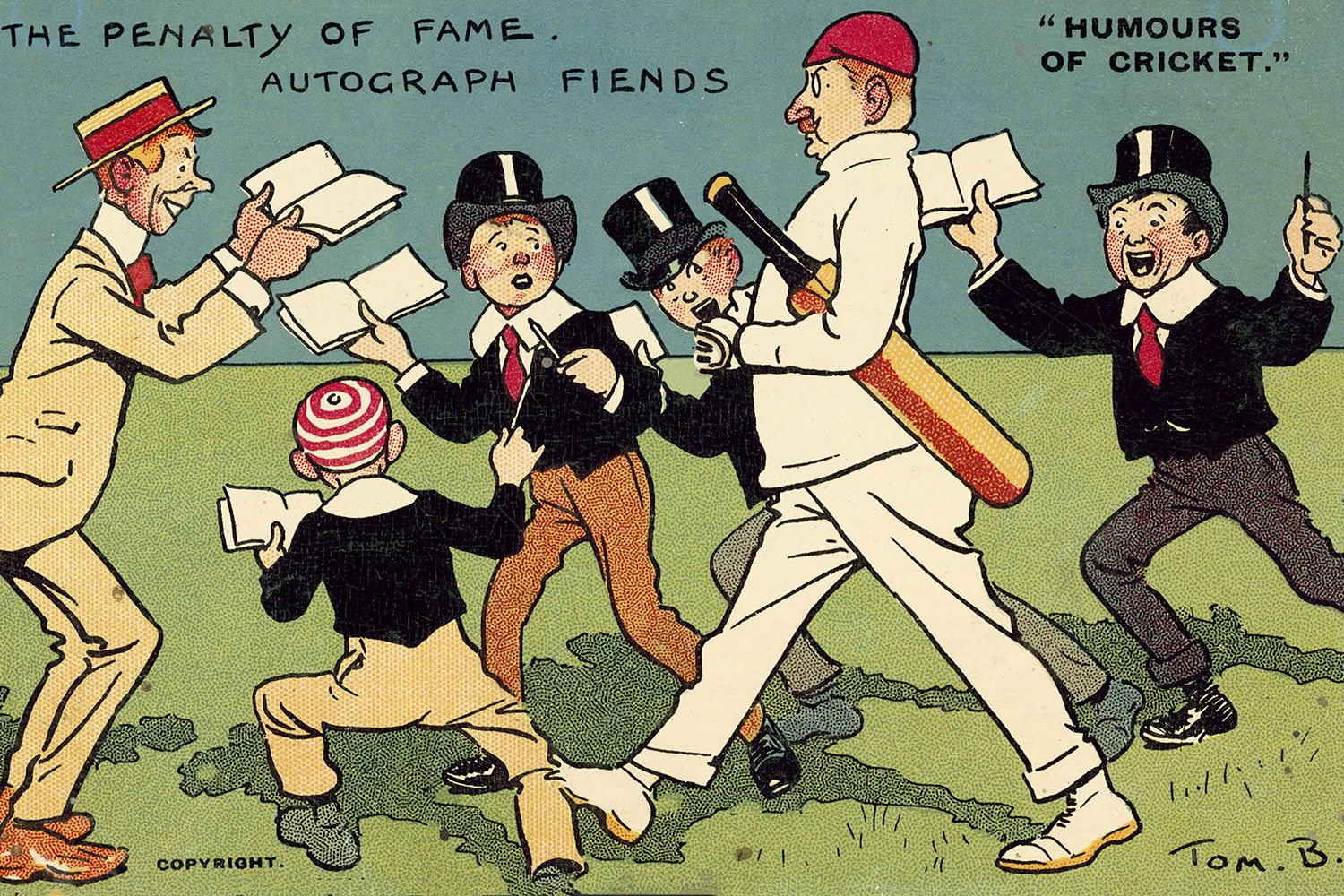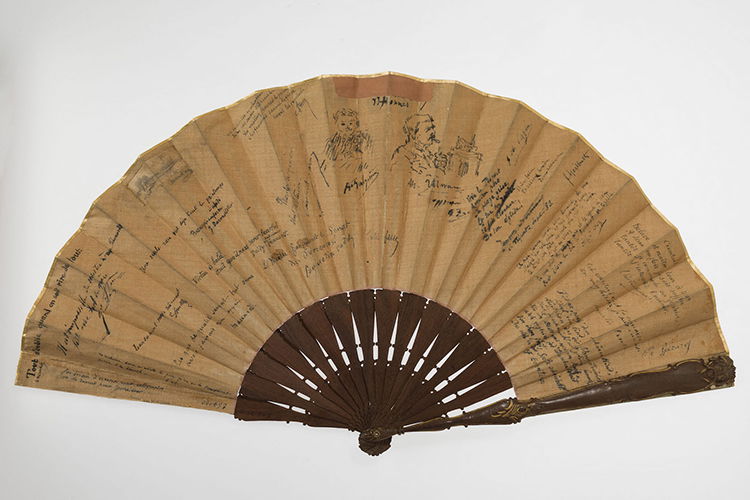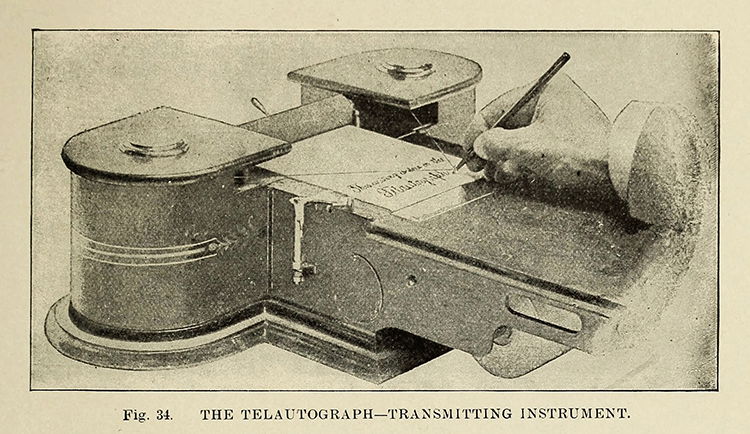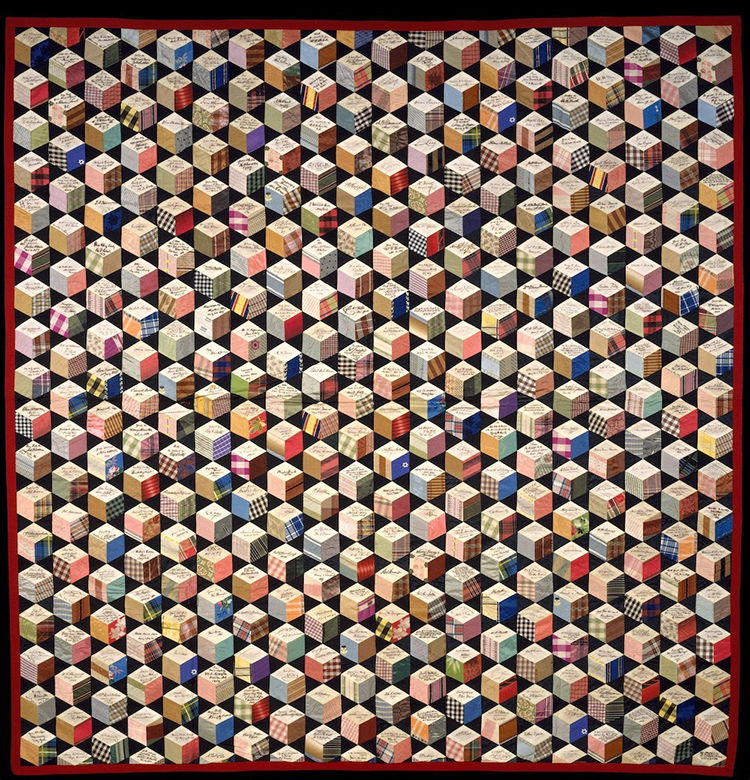The Autograph Fiend
There was no known remedy available to help those afflicted with ‘autographomania’. Spreading far and wide in the late 19th century, the obsession with collecting autographs held ‘all sorts and conditions of men in its deadly grip’.

'Drawbacks of celebrity: a cricketer pestered by autograph hunters', by Tom Browne, early 20th century.
‘No one will ever be as fond of my pets as I have been’, lamented the American lawyer Adrian H. Joline at the conclusion of his Meditations of an Autograph Collector (1902). He was not speaking of corgis and calicos, but of handwritten artefacts: ‘I look down upon them almost as one might upon children whom he must leave behind.’ Joline was one of many collectors suffering from what the 19th-century librarian Theodore F. Dwight diagnosed as ‘autographomania’: a collective obsession, which intensified in Britain and the US during the 1880s and 1890s, with the handwriting of both notable individuals and intimate familiars.
Within months of Joline’s meditations, British illustrator Harry Furniss asked a question in the Strand Magazine: ‘Is there any inoculation possible to avert autograph fever?’ Another collector replied: ‘autograph fever clutches all sorts and conditions of men in its deadly grip’. That both should employ the language of illness reveals what was at stake. One person’s quaint pastime is another’s consuming infatuation. That same year, P.G. Wodehouse wrote a tale for Punch about a man who ‘passed safely through a sharp attack of Philatelism’, or, stamp collecting, only to fall prey to ‘a rather nasty bout of Autographomania’.
Those afflicted with signatures were a recognised type. ‘The autograph fiend’ was often portrayed as originating in the US. One account, in an 1887 issue of the Leicester Chronicle, finds a fiend from Chicago impersonating a courier in order to penetrate the House of Commons, stuffing the members’ name cards into his pocket on the fly. The English social reformer Laura Ormiston Chant received 1,307 autograph requests during her four-month tour through the US in 1890. And, amid characteristically pithy correspondence, Oscar Wilde recounts how he employed three secretaries while travelling a similar route in the 1880s: one to receive flowers; another to sign autographs; and a final unshorn attendant to clip trimmings from his locks – something the writer’s fanbase desired. The autographer supposedly developed a condition akin to carpal tunnel syndrome. Wilde’s hair surrogate went bald at an early age.

While it reached a fever pitch during the fin de siècle, autograph collecting is a much older tradition. Collecting in the US began in earnest during the 1810s, while 16th-century German students gathered specimens in dedicated autograph books. Bear in mind that ‘autograph’ in this context stands for any sample of handwriting, not solely the signature. Only toward the end of the 19th century did the pastime turn pathological, when larger cultural and commercial forces vitalised what we now call autographs.
Several arguments can be made in tandem for why autographomania arrived when it did. It coincided, for instance, with the rise of transatlantic celebrity, the formalisation of signed cheques as a monetary instrument and an emerging market for the resale of signatures. This is also the period in which handwriting gained a newfound aura thanks to the popularity of chirography and graphology: pseudoscientific attempts to find correspondence between a person’s moral character and the shape of their scribbled characters. After Charles J. Guiteau assassinated President James A. Garfield in 1881, there was a flurry of discussion about his penmanship. ‘An inspection of the autograph gave decided evidence of nervousness in its formation, the “C” especially being much elongated and the curve lines irregular.’ The criminologist Cesare Lombroso took this equation even further. In 1878 he updated his influential book Criminal Man to include a section on handwriting, claiming that graphology not only reveals a person’s guilt over past actions, but also the probability they will commit future crimes.
This was an era of new media technologies as well, which threatened the primacy of handwriting as a means for communication at a distance. The phrase ‘autograph fiend’ proliferates shortly after the introduction of commercial typewriters in 1874. During the following three years, both the telephone and phonograph arrived on the scene, allowing one’s voice to reach far beyond the body, a quality previously reserved for written words. In 1893 the teleautograph debuted. A cousin of the telegraph, this device was described by the Savannah Tribune as a 1,000-mile-long pen, beginning in Boston and ending in Chicago, with the consequence that ‘a man’s presence is no longer necessary in a place to affix his autograph’. A signature could be signed remotely for the first time.

These 19th-century collectors preserved a dying form of intimacy. The autograph fiend sought authenticity, which often meant resorting to trickery, for a signature signed under coercion is no better than a rubber stamp. A New Orleans collector, quoted in the Wisconsin Weekly Advocate in 1900, believed that in ‘autograph hunting, the end always justifies the means, no matter how mean they may be’. One effective technique was to write to authors and ask obscure questions, hoping to provoke a baffled, signed response. The collector lists his successful subject matter: ‘Wienerwursts, rubber overcoats, glass eyes, kleptomania, educated hogs, jimjams, cold pie, sea serpents’ and more. Yet there was something like honour among fiends. The Spectator praised John Horne, author of The Diversions of an Autograph-Hunter (1895), for conducting his chase ‘in a sportsmanlike way’.
In Britain, autograph collecting emerged as an offshoot of the Victorian fascination with bric-à-brac. Whereas the 17th- and 18th-century ‘connoisseur’ focused on fine art, now it was curios that captured the imagination. Mummies, seaweed and signatures became precious acquisitions. Even the royal family could not resist. Queen Victoria was gifted an ‘autograph fan’ from the Prince and Princess of Wales in 1887 and collected signatures on its folds until her death in 1901. It is no coincidence that autographomania flourished near the British Empire’s peak. For both these collectors and their nation, ‘an imperial collector writ large’, writes Maya Jasanoff, ‘collecting was a means of acquiring power, status and a new self-image’.
In the US, the vanity of autograph collectors chafed against the efficacy of collective, political action. William J. Wilson, an African American journalist who signed under the penname ‘Ethiop’, compared Edgar Allan Poe’s graphological hobby with the Rochester Ladies’ Anti-Slavery Society’s Autographs for Freedom (1853), a book of signed, abolitionist statements, featuring Frederick Douglass, Annie Parker and many others. According to Wilson, Poe merely showed that ‘the autograph was an index to the proportions and qualities of the mind’, while Autographs for Freedom ‘coupled’ the signature’s beauty to ‘its nobler biases, utility and results’. Soon after, however, these nobler biases became a source of potential profit for US companies.

During the 1880s and 1890s, several fashionable trends injected signatures into American social life. ‘The Autographic Plaque’, for example, merged collecting with courtship. Cardboard discs were made with spaces for 50 names: ‘An unwritten law in this fad decrees that each autograph writer must produce a dime with his signature’, reported a Kansas paper in 1892. Once the disk was full, its owner would have five dollars, which could be used to pay the plaque company for a bone china cast. ‘It is a great scheme for the girls who have little or nothing to do, and signatures are greatly in demand’, ends the article, taking the source of this ‘demand’ as a given, while declining to elaborate who, exactly, these bored girls were.
Other autographic rituals occurred around the dining table. According to Detroit’s Plaindealer, the autograph tablecloth was 1890’s ‘very latest fad’. Made from a square yard of linen, ‘embroidered in Kensington stitch’, it featured the autographs of one’s ‘most distinguished acquaintances, or dearest friends’. What seems kitsch today, once had grand European connotations. Three years later, another paper claimed that these tablecloths were the latest ‘craze’ in Vienna. This craze then moved from the table to the bedroom, with the Cleveland Gazette asserting that, as of 1903, ‘autograph quilts’ were now in vogue. In reality they were nowhere near novel, having been sewed in the US since at least the 1830s. There were also items that displayed handwriting on different parts of the body. Signet rings engraved with autographs were said to be trending in Washington D.C. during 1885; American periodicals became fascinated by how a Belgian bride used her wedding dress as a guestbook in 1900; and, three years later, a story surfaced about the telegraph operator P. W. Williams. He wears a ten-gallon cowboy hat, covered in signatures of the famous, while sending out messages to distant stations.
Hunter Dukes is the author of Signature (Bloomsbury, 2020).